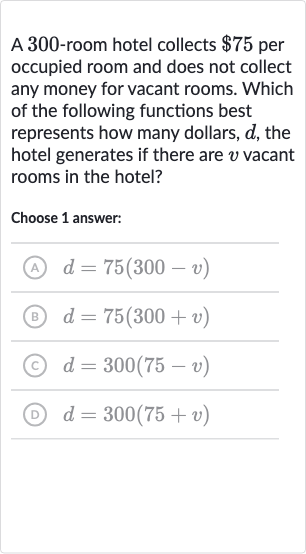AI tutor
Full solution
Q. A -room hotel collects per occupied room and does not collect any money for vacant rooms. Which of the following functions best represents how many dollars, , the hotel generates if there are vacant rooms in the hotel?Choose answer:(A) (B) (C) (D)
- Define Variables: Let's define the variables and understand the problem.The hotel has a total of rooms. It collects for each occupied room. If there are vacant rooms, then the number of occupied rooms is , because the total number of rooms is .
- Find Total Dollars Function: Now, we need to find the function that represents the total dollars, , the hotel generates from the occupied rooms. Since the hotel collects per occupied room, we multiply the number of occupied rooms by .
- Perform Multiplication: Perform the multiplication to get the function for .This represents the total dollars generated from the occupied rooms.
- Compare Function Options: We can now compare the function we found with the given options to determine the correct answer.(A) matches our function.(B) suggests the hotel earns money for vacant rooms, which is incorrect.(C) suggests the hotel earns a variable amount per room, which is incorrect.(D) suggests the hotel earns more money for more vacant rooms, which is incorrect.
- Correct Answer: The correct answer is the one that matches our function.(A) is the correct function that represents how many dollars, , the hotel generates if there are vacant rooms in the hotel.

